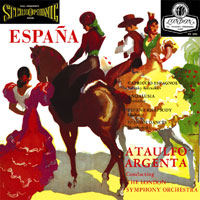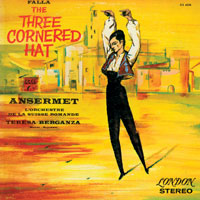España
Falla • The Three Cornered Hat
ike "Shaded Dog," the phrase "Blue Back" has special meaning for vinylphiles. It is the nickname for the classic London stereo LPs from the 1950s and '60s, whose sleeves do, in fact, have robin's-egg-blue backs. Due to a split in ownership of Decca Records, the London label was used for issue of English Decca LPs in the US, Canada and Latin America. Decca was renowned for its stereo recording technique, which engineers Arthur Haddy, Roy Wallace and Ken Wilkinson debuted in 1954. It made use of the famous "Decca tree," a stereo microphone system for recording orchestras that was responsible for the big, vivid sound of Decca/London LPs. Original Recordings Group's España and The Three Cornered Hat are reissues of well-regarded and hard-to-find London Blue Backs. España collects Latinesque works that include Rimsky Korsakov's symphonic spectacular Capriccio Espagnol and Chabrier's España Rhapsody. In keeping with the program, Spanish conductor Ataúlfo Argenta led the London Symphony through this zesty repertoire. Trading artistic austerity for vitality and verve, it is a far cry from long-haired classical music. España takes a cue from Arthur Fiedler and the Boston Pops with a choice of more popular fare and effervescent playing. In the same vein, one of Decca/London's default pairings -- Ernest Ansermet and the orchestra he founded, the Orchestre de la Suisse Romande -- recorded Manuel de Falla's ballet The Three Cornered Hat. Ansermet was the first conductor of the work, and he shows great understanding of it, his reading eliciting vivacious playing along with pellucid soloing from soprano Teresa Berganza. Each title comprises a pair of LPs cut at 45rpm and pressed at RTI in California. The faster speed is much more unusual for classical records than jazz releases, because the reduced running time of 45rpm LPs -- about ten minutes maximum per side -- can make for frequent and awkward interruptions with long compositions. Here, the music breaks logically and naturally. The music on España is actually short enough to include a duplicate of side one as side four, a useful repetition, given how often the first side will likely be played. But the most important reason to cut LPs at 45rpm is improved sound, and these reissues deliver in abundance. The soundscapes are huge -- wall to wall and as deep as your audio system will provide. Horns cascade, tympani is quick-paced and taut, and strings resound in mass while achieving adept delineation. Dynamics are massive yet scale up and down nimbly and smoothly. I have a dozen or so original Blue Backs, some recorded in the same venues as these titles, but none conveys the sense of the whole orchestra and the individual musicians as well as these LPs. In fact, I don't think I've ever heard an orchestra
captured with greater expansiveness and focus. While one of these recordings is
over 50 years old and the other is almost there, they both sound fresh, and the music is
exhilarating, even for those who don't generally listen to orchestral recordings. |


